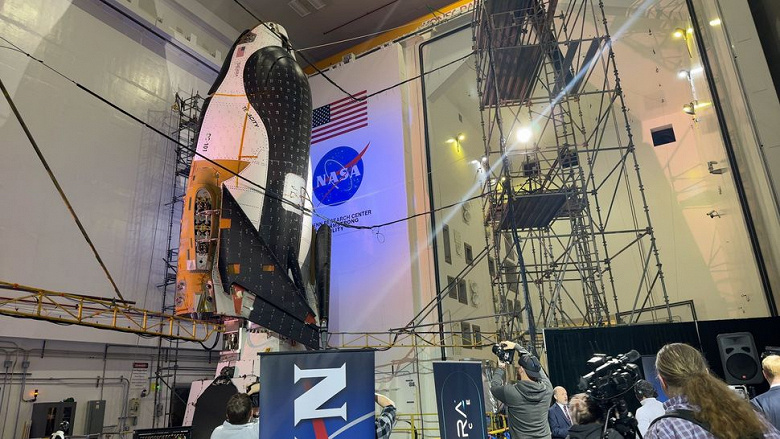The first launch of a space plane is planned for the first half of 2024
February 1 NASA and Colorado-based Sierra Space provided an in-depth review of Dream Chaser — a private space plane that will make its first flight to the ISS this year.
The event took place at NASA's Neil Armstrong Test Site. Dream Chaser and its cargo module — vehicles called «Tenacity» and «Shooting Star» — were folded vertically, as they will be during launch. Height of «duet» was 16.8 meters.
«Turning bold dreams into bold actions requires enormous tenacity, persistence, confidence, determination and passion. And so we chose names in honor of these emotional characteristics that help get through difficult times», — said former NASA astronaut Tom Marshburn, chief medical officer of Sierra Space.
Tenacity's highly anticipated debut will carry cargo to the ISS for NASA. But before the start, Tenacity and Shooting Star must pass many tests. For example, tests in the Mechanical Vibration Installation of the NASA center. These tests expose vehicles to various harsh conditions they will encounter during a mission — for example, the shaking they will experience during the launch, which, according to plans, should be carried out on the United Launch Alliance Vulcan Centaur rocket.
«All the tests we have conducted over the past six years, as well as development tests — technical and on autonomy and aerodynamics, and the remaining — these are environmental tests comparable to what will actually happen on the launch pad during launch. These tests involve reproducing the space environment and the vacuum of space in a thermal vacuum chamber», — said Sierra Space CEO Tom Weiss.
In 2016, Sierra Space received a multi-year Commercial Resupply Services-2 (CRS2) contract from NASA to support at least six cargo delivery missions to the ISS.
NASA continues to partner with US private industry when it comes to transporting cargo and getting astronauts to the ISS. For example, the agency signed commercial agreements with Boeing and SpaceX back in 2014. Elon Musk's company has already launched seven crew sets on the ISS and is preparing for the eighth. Boeing intends to make the first test launch of the Starliner capsule with a crew this spring.
«They continue the line of zero-gravity research that is currently being done on the ISS and that we hope to do in the future. In particular, the development of new materials», — Marshburn said.
«Many people do not realize that the cytoskeletal structure of both human cells and bacteria changes in weightlessness and changes how they respond. NASA was able to develop new vaccines, grow crystals and much more that can be done in zero gravity», — he added.
While Shooting Star will retain its name and burn up in Earth's atmosphere after completing its only mission, after landing Tenacity will begin preparations for its next launch. The space plane is designed to carry out up to 15 missions.
Tenacity is designed to carry more than 3540 kg of cargo, and in future expeditions this figure may increase to 5215 kg. The main purpose of this spacecraft is to deliver more than 1590 kg of cargo and experimental samples back to Earth.
Tenacity and Shooting Star are scheduled to launch in the first half of this year from Cape Canaveral Launch Center in Florida.

